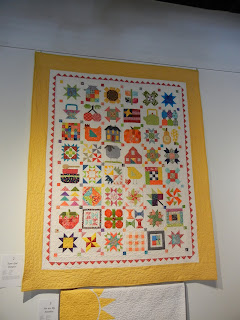The first few quilts featured flowers prominently.
 |
| They're Not Your Poppies by Karen de la Durantaye |
 |
| Sundays with Auntie Rose by Karen de la Durantaye |
 |
| Abounding Tulips designed by Marilyn Fisher top by Delaney Ann Prins; quilted by Janet Haines |
 |
| Detail of Abounding Tulips |
 |
| Happy Scrappy Glorious Album designed by Kim McLean and Barbara Schippa; top by Barbara Schippa quilted by Janet Haines |
 |
| Flower Pots designed by Kim McLean top by Kathleen Myers; quilted by Darla Parks |
 |
| Lolli Dot designed by Kim McLean top made and adapted by Nora Slikkers quilted by Karen Kielmeyer |
 |
| Ties That Bind by Ellie Bremer |
 |
| Detail of Ties That Bind |
 |
| Farm Girl Sampler designed by Lori Holt made by Sue Fabiano |
The following is a "One Block Wonder" quilt.
 |
| Aurora Borealis - one block wonder design Made by Janet Judson |
The following is a small quilt I have the pattern for and still hope to make. The first picture shows you the scale of the pieces (tiny).
Here is the full quilt. It's about 24" square.
 |
| Diamond Log Cabin designed by Little Bits top by Mary Raak; quilted by Char Koppernal |
Following is a quilt that catches my eye every time - you don't have to wonder why!
 |
| Elmer the Elephant designed by Violet Craft Made by Greg Hugel |
Speaking of elephants, this is a cute one!
 |
| Ellie designed by "bj designs & patterns" Made by Arla Beukema |
 |
| We Could All Use a Goat (a.k.a. Frasier) by Karen de la Durantaye |
 |
| Detail of We Could All Use a Goat |
 |
| Winter Birds designed by Nancy Halvorsen Made by Myra Morrison |
 |
| Heart of Hearts designed by Ellie Brown top by Barbara Vanden Bosch quilted by Living Threads Ministries |
 |
| Detail of Heart of Hearts |
 |
| Flower Burst design inspired by online picture made by Living threads volunteers quilted by Living Threads Ministries |
 |
| Labyrinth by Barbara Schippa |
 |
| You are My Sunshine by Dawn Veltema |
 |
| Potters Wheel designed by Briar Hill Designs Made by Sarabeth Carr |
This collection was from a shared class:
The common feature was this "bricked" background made from only two fabrics.
 |
| Tree Shadow by Kathy Ryzenga from a technique taught by Gloria Loughman |
These three quilts were made by a mother, daughter, and granddaughter. They worked on them together once a week over a school year.
 |
| Design: Jenny Haskins Heritage Quilt |
The following quilt was inspired by and made from her wedding dress (once her daughter decided not to wear it):
 |
| Wedding Dress Recycled designed by Cheryl Scott top by Cheryl Scott; quilted by Deloa Jones |
 |
| Medallion designed by Edyta Sitar Made by Nancy Einfeld |
After the show, I shopped at a quilt shop in Holland that I hadn't visited before. It was a nice shop but I didn't make any purchases that day.




























